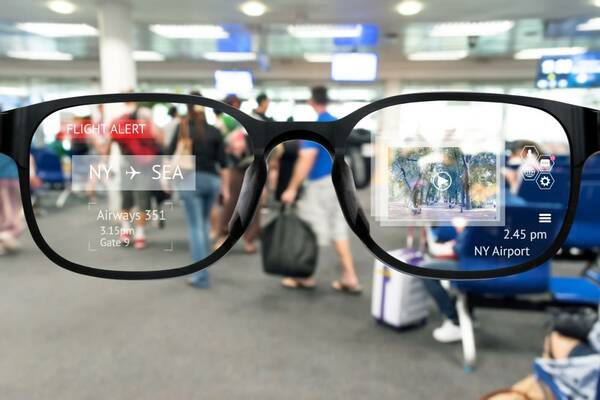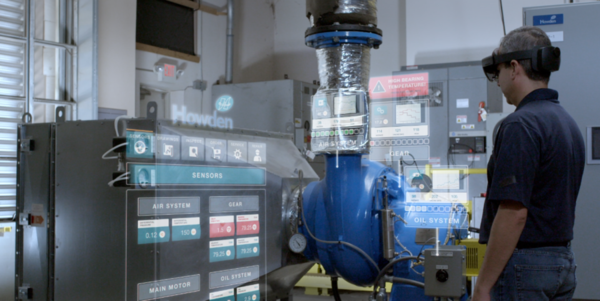Enterprise AR Meets Machine Vision
The use of augmented (AR), virtual (VR) and mixed reality (MR) devices is burgeoning in enterprise environments—from the R&D lab to the factory floor and out in the field, with a broad range of applications such as training, design and product development, maintenance/repairs, and quality assurance. Use of AR/VR solutions in 2020 is expected to hit $1.5 billion in retail applications and $1.4 billion in the manufacturing sector, with commercial uses cases accounting for $2.6 billion in training, and $914 million in industrial maintenance.1
The hallmark of AR/MR systems is that they can blend real-time images of the real world with digital information. Typically, this is done by either by overlaying 2D projected text and/or graphics onto a transparent surface, or by integrating 3D virtual images with images from the environment. While the dividing line can be a bit blurry between AR and MR, augmented reality generally is where information is overlaid on the user’s background environment—for example, in a pair of smart glasses.

Example of an augmented reality application, with information displayed by a pair of smart glasses while the background environment is still visible through the transparent lenses.
By contrast, in mixed reality (sometimes also referred to hybrid reality) virtual objects can be mapped to the physical environment (not just overlaid in front of a view of the background view). This visual integration allows users to “quickly and easily interact with those digital objects to enhance their experience of reality or improve efficiency with certain tasks.”2
Where Do Vision Systems Come In?
Some AR/VR devices are already designed with embedded cameras. These cameras capture images of the user’s environment and combine the images together with digitally generated content to present an integrated image. Called “video see-through,” devices that employ this technology (such as the HTC Vive VR headset) have built-in cameras used to create AR experiences.3
The need to closely match digital information and virtual representations with views of the real-world environment is driving the integration of cameras and computer vision capabilities within AR/MR devices. In fact, traditional machine vision companies can expect to see a boom in enterprise AR/VR use, with a CAGR of 70% through 2025.4
For example, BAE Systems used the Microsoft Hololens to create interactive MR experiences to enhance training and guidance for manufacturing workers. Embedded cameras in AR headsets allows BAE’s seasoned engineers to document their work processes and overlay instructions to help guide less experienced workers in various tasks. Using these guided step-by-step instructions, BAE has been able to reduce the time for assembly of battery cells and for training new workers.
Similarly, global engineering firm Howden was able to use existing 3D models to create step-by-step instructions to support their customers with onsite maintenance and repairs of mission-critical systems, reducing unplanned downtime and improving overall maintenance strategies.

(Image from PTC)
Ongoing improvements in hardware resolution and field of view, increased mobility via wireless technology, and wider availability of better AR software will help drive enterprise adoption of the technology.5 Dan McCarthy delves further into the topic of Enterprise AR/VR and machine vision in a feature article on AIA Vision Online, in which Radiant’s own CEO Doug Kreysar provides some perspective.

CITATIONS
- Worldwide Augmented and Virtual Reality Spending Guide, market forecast report from International Data Corporation (IDC), November 27, 2019.
- Limarc, “Augmented Reality vs. Mixed Reality vs. Virtual Reality”, Hackernoon, August 20, 2019. https://hackernoon.com/augmented-reality-vs-mixed-reality-vs-virtual-reality-ik8730gv (retrieved 1/10/20)
- Kore, A., “Fundamentals of display technology for Augmented and Virtual Reality”, Hackernoon, September 16, 2018. https://hackernoon.com/fundamentals-of-display-technologies-for-augmented-and-virtual-reality-c88e4b9b0895 (Retrieved 12/14/19).
- Augmented and Virtual Reality Market Outlook – 2025: Augmented and Virtual Reality Market by Organization Size (Large Enterprises and Small & Medium Sized Enterprises)), Application (Consumer and Enterprises), Industry Vertical (Gaming, Entertainment & Media, Aerospace & Defense, Healthcare, Education, Manufacturing, Retail, and Others): Global Opportunity Analysis and Industry Forecast 2018-2025, Allied Market Research, December 2018
- Horwitz, J., “4 enterprise AR trends to watch in 2020”, Venture Beat, December 27, 2019 (Retrieved 1/10/20)
Join Mailing List
Stay up to date on our latest products, blog content, and events.
Join our Mailing List
